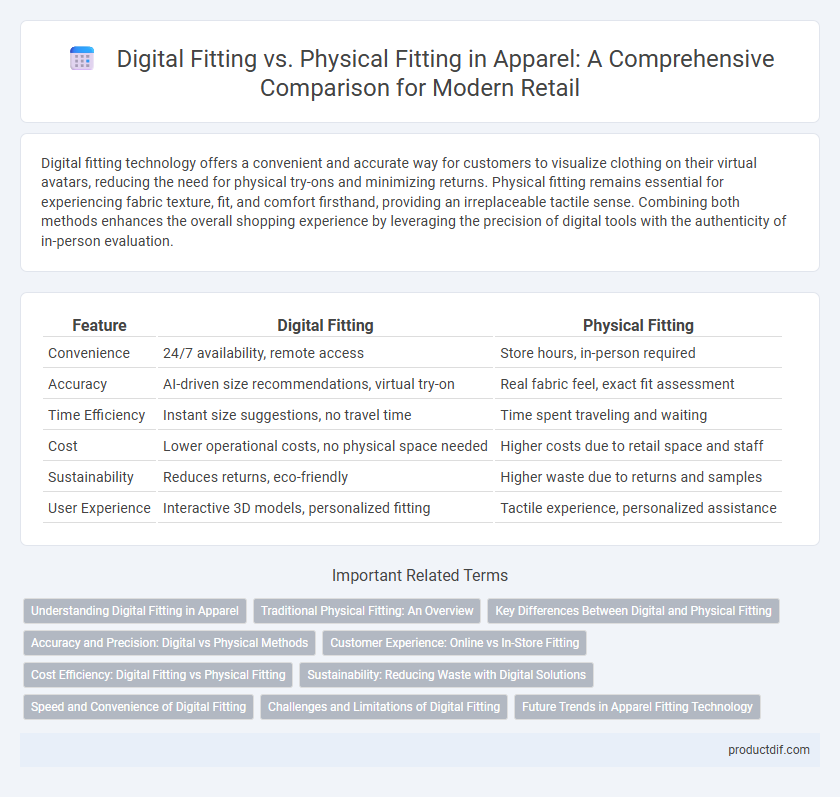Digital fitting technology offers a convenient and accurate way for customers to visualize clothing on their virtual avatars, reducing the need for physical try-ons and minimizing returns. Physical fitting remains essential for experiencing fabric texture, fit, and comfort firsthand, providing an irreplaceable tactile sense. Combining both methods enhances the overall shopping experience by leveraging the precision of digital tools with the authenticity of in-person evaluation.
Table of Comparison
| Feature | Digital Fitting | Physical Fitting |
|---|---|---|
| Convenience | 24/7 availability, remote access | Store hours, in-person required |
| Accuracy | AI-driven size recommendations, virtual try-on | Real fabric feel, exact fit assessment |
| Time Efficiency | Instant size suggestions, no travel time | Time spent traveling and waiting |
| Cost | Lower operational costs, no physical space needed | Higher costs due to retail space and staff |
| Sustainability | Reduces returns, eco-friendly | Higher waste due to returns and samples |
| User Experience | Interactive 3D models, personalized fitting | Tactile experience, personalized assistance |
Understanding Digital Fitting in Apparel
Digital fitting in apparel leverages 3D body scanning technology and virtual try-on tools to create accurate, personalized garment simulations that enhance sizing precision and reduce returns. This approach streamlines the shopping experience by allowing customers to visualize fit and style virtually, minimizing the limitations of traditional physical fitting rooms. Integrating AI-driven data analytics further refines garment customization, enabling brands to deliver optimized fits tailored to individual body shapes.
Traditional Physical Fitting: An Overview
Traditional physical fitting involves trying on garments in-store to assess comfort, fit, and style, allowing immediate tactile feedback and adjustments. This method relies heavily on in-person interaction and customer service expertise to ensure accurate sizing and satisfaction. Despite the rise of digital fitting technologies, physical fitting remains essential for its tangible experience and immediate garment evaluation.
Key Differences Between Digital and Physical Fitting
Digital fitting leverages 3D body scanning and virtual try-on technology to provide accurate size recommendations and enhance online shopping experiences, reducing returns and improving customer satisfaction. Physical fitting requires in-store trials, offering tactile feedback and immediate garment adjustments but is limited by location and convenience. The key difference lies in digital fitting's scalability and data-driven personalization versus physical fitting's hands-on, real-world garment assessment.
Accuracy and Precision: Digital vs Physical Methods
Digital fitting leverages 3D scanning and AI algorithms to deliver highly accurate measurements tailored to individual body shapes, reducing human error common in physical fittings. Physical fitting relies on manual measurements and trial garments, which may introduce variability due to inconsistent technique and wearer movement. Digital methods offer superior precision by consistently replicating exact body dimensions, enhancing the overall fit and customer satisfaction in apparel design.
Customer Experience: Online vs In-Store Fitting
Digital fitting technology enhances the customer experience by offering personalized, accurate measurements through augmented reality and 3D body scanning, reducing the need for physical try-ons and lowering return rates. In-store physical fitting allows customers to feel fabric textures and assess garment fit in real-time, providing immediate tactile feedback and style confidence. Combining digital and physical fitting methods creates a seamless omnichannel shopping experience, boosting customer satisfaction and brand loyalty in the apparel industry.
Cost Efficiency: Digital Fitting vs Physical Fitting
Digital fitting significantly reduces costs by eliminating the need for multiple physical samples, minimizing material waste, and decreasing labor expenses associated with traditional fittings. Physical fitting incurs higher expenses due to fabric usage, shipping of prototypes, and time-consuming in-person adjustments. Investing in digital fitting technology enhances cost efficiency through faster design iterations and scalable virtual try-ons without the overhead of physical production.
Sustainability: Reducing Waste with Digital Solutions
Digital fitting technologies significantly reduce apparel waste by minimizing the need for multiple physical samples and returns, leading to lower fabric consumption and carbon emissions. Virtual try-ons enable precise sizing and customization, cutting down on overproduction and unsold inventory that often end up in landfills. Brands adopting digital fitting solutions contribute to sustainable fashion by optimizing resource use and promoting circular economy principles.
Speed and Convenience of Digital Fitting
Digital fitting technology accelerates the try-on process by allowing customers to visualize clothing instantly through virtual avatars or augmented reality, eliminating the need for physical changing rooms. This innovation saves time by reducing wait lines and minimizes the hassle of multiple outfit changes, enhancing overall convenience. Retailers benefit from increased customer satisfaction and reduced fitting room congestion, enabling a seamless shopping experience.
Challenges and Limitations of Digital Fitting
Digital fitting technology in apparel faces challenges such as inaccurate size predictions due to variation in body shapes and fabric behavior that virtual models cannot fully replicate. Limitations include insufficient tactile feedback, making it difficult for consumers to assess material comfort and garment fit effectively. These constraints hinder widespread adoption despite improvements in 3D scanning and augmented reality capabilities.
Future Trends in Apparel Fitting Technology
Digital fitting technology leverages 3D body scanning and augmented reality to provide accurate size recommendations and virtual try-ons, reducing returns and enhancing customer satisfaction. Advances in AI-driven fit prediction models and smart fabrics are expected to further personalize apparel fitting, creating seamless omnichannel shopping experiences. Physical fitting will evolve with hybrid solutions combining virtual previews and precise in-store measurements to optimize fit accuracy and minimize waste.
Digital fitting vs Physical fitting Infographic

 productdif.com
productdif.com